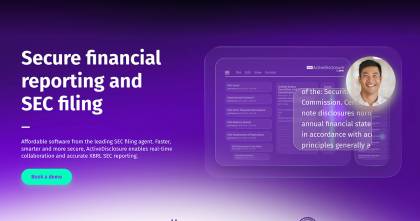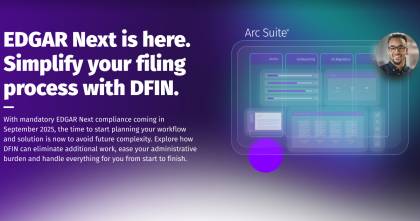Preparing an S-1 IPO requires meticulous attention to detail and a deep understanding of regulatory requirements. Companies must provide comprehensive financial statements, detailed business descriptions, and extensive risk disclosures. It’s the company's formal introduction to the public and the level of detail can be overwhelming, especially for first-time filers. Learn who needs to file an S-1 IPO registration statement and why.
What Is an S-1 IPO Form?
An S-1 IPO is a document filed by a US-based company to the U.S. Securities and Exchange Commission (SEC) when it plans to go public through an Initial Public Offering (IPO). This document provides comprehensive information about the company, including its business model, financial statements, risk factors, and the intended use of the proceeds from the IPO.
The SEC requires that this form is filed before public shares can be issued for a company, so due diligence and preparation are crucial to meet the timeline for a successful IPO.
What is required in the S-1 IPO Form?
In advance of an IPO, the SEC requires that companies provide detailed information about their business model, share offerings, the price methodology that was used by underwriters and other details. Within the S-1 Form, you will need to explain the business model and how it compares with peers, the process of setting share prices and the planned use of capital raised by selling shares. You will also need to go into detail on the company's board of directors and outside legal counsel if there are other business relationships among these entities that could affect the business offering. Typical content for these filings also includes disclaimers on risk factors, projected use of proceeds and underwriter details.
On the prospectus — which is part of the S-1 Form — you will discuss the business operations and its financial condition, the percentage of the business being sold as public shares, the underwriters who are involved in the IPO process, and total proceeds to be raised by the IPO. Everything on the Form S-1 must be true and complete at the time of filing. If the SEC finds that some critical information was omitted from the S-1, there could be penalties.
Normally the SEC requests additional information, so the Form S-1 may need to be amended. Rather than file a second S-1 with the SEC, you can use the related S-1/A if amendments become necessary.
Who Needs to File an S-1 Form?
Any US-based company that is going public with intention to sell its shares on one of the major exchanges in the US must file an S-1. While this is usually done in conjunction with a company's IPO, there are times when companies will file an S-1 even if they aren't planning for an IPO. Companies who choose a direct listing option to take their company public also need to file an S-1, as well as public companies looking to sell additional shares in a follow-on or secondary offering.
The S-1 is filed for domestic companies; foreign-held companies that want to sell shares in the U.S. have a different form type, known as the F-1.
Why Is an S-1 Necessary?
An S-1 Form is necessary for regulatory purposes, but its value extends far beyond satisfying legal requirements. Consider that interested individuals who are thinking about buying a security can review the S-1 to learn more about the opportunity. While a big IPO — such as that for a Silicon Valley unicorn company — may be high publicized in financial news media, plenty of other companies go public that do not have household names.
Whether the business is a technology sector unicorn or more quotidian, the S-1 Form is generally the easiest way to uncover relevant financial information so that investors can evaluate the investment. Because the S-1 explains the company's valuation, current financials, competitors, market opportunities and other metrics, it allows investors to weigh their options and develop the necessary confidence to buy shares. It gives these potential investors the chance to assess key financial statements, risks, growth strategies and more.
What Are Some Common Mistakes Made During S-1 IPO Filing?
A smooth S-1 filing process is key to helping an IPO remain on track. Unfortunately, many companies are not IPO ready. For example, companies need to coordinate with auditors, legal counsel, and underwriters to prepare and submit the filing on schedule. Delays due to poor financial reporting, and governance can lead to increased costs and missed market opportunities.
This is why having SEC filing software and virtual data rooms can be important for filers. These software platforms help keep details organized and provide automated pre-EDGAR validation and mock SEC reviews to ensure there are no potential oversights that can lead to trouble.
What Is the Best Way to File the S-1 Form?
S-1 form is submitted to the SEC through the EDGAR (Electronic Data Gathering, Analysis, and Retrieval) system. There are a range of software options for preparing SEC forms and transmitting IPO filing documents to EDGAR — so what sets DFIN’s software, ActiveDisclosure℠, apart from the others?
ActiveDisclosure℠ contains guided workflows that make it easy to loop in key stakeholders for a collaborative work effort. When everyone can work collaboratively within the same document, there's less chance of administrative errors or version control issues that could lead to inaccurate reports or SEC S-1 filings.
Our software is built with validation and tagging features that make it faster and easier to develop compliant and accurate financial reports. Built-in checks within the system prevent you from submitting a document that is incomplete or fails to meet one or more filing requirements.
Plus, there is 24/7/365 customer support should a question arise during the filing process, which is critical when dealing with tight IPO timelines and any last-minute changes. At DFIN, we consider ourselves partners with all our customers. We are here to assist with all aspects of the SEC filing process, from the S-1 to all of the future SEC regulatory reporting requirements for publicly traded companies.
IPOs can be intensely time-consuming, but there are resources to help speed up parts of the process. Spend time focusing on the metrics that will increase valuation and not on the regulatory documentation. From IPO readiness to public debut and beyond, let DFIN help you throughout the process with our SEC filing expertise, software, and solutions.


